英文文献阅读笔记精编版
文献阅读笔记-Evolution...
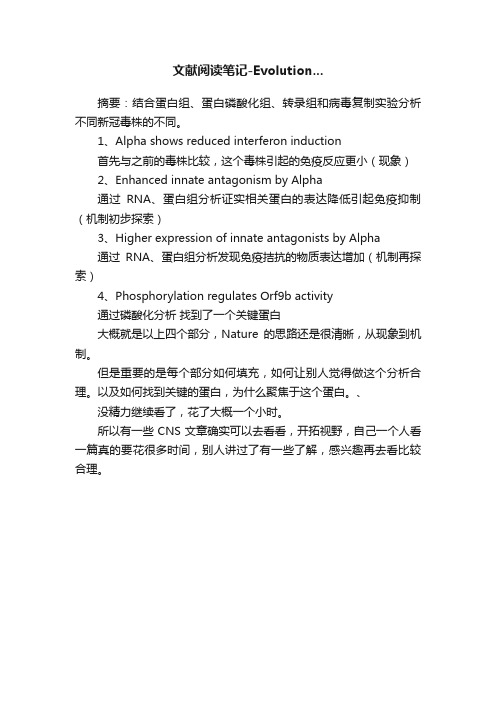
文献阅读笔记-Evolution...
摘要:结合蛋白组、蛋白磷酸化组、转录组和病毒复制实验分析不同新冠毒株的不同。
1、Alpha shows reduced interferon induction
首先与之前的毒株比较,这个毒株引起的免疫反应更小(现象)
2、Enhanced innate antagonism by Alpha
通过RNA、蛋白组分析证实相关蛋白的表达降低引起免疫抑制(机制初步探索)
3、Higher expression of innate antagonists by Alpha
通过RNA、蛋白组分析发现免疫拮抗的物质表达增加(机制再探索)
4、Phosphorylation regulates Orf9b activity
通过磷酸化分析找到了一个关键蛋白
大概就是以上四个部分,Nature的思路还是很清晰,从现象到机制。
但是重要的是每个部分如何填充,如何让别人觉得做这个分析合理。
以及如何找到关键的蛋白,为什么聚焦于这个蛋白。
、没精力继续看了,花了大概一个小时。
所以有一些CNS文章确实可以去看看,开拓视野,自己一个人看一篇真的要花很多时间,别人讲过了有一些了解,感兴趣再去看比较合理。
英语读书笔记(精彩10篇)
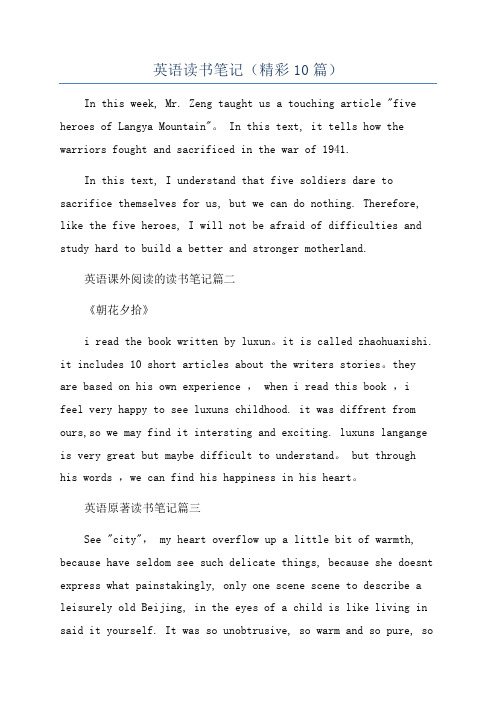
英语读书笔记(精彩10篇)In this week, Mr. Zeng taught us a touching article "five heroes of Langya Mountain"。
In this text, it tells how the warriors fought and sacrificed in the war of 1941.In this text, I understand that five soldiers dare to sacrifice themselves for us, but we can do nothing. Therefore, like the five heroes, I will not be afraid of difficulties and study hard to build a better and stronger motherland.英语课外阅读的读书笔记篇二《朝花夕拾》i read the book written by luxun。
it is called zhaohuaxishi. it includes 10 short articles about the writers stories。
they are based on his own experience , when i read this book ,ifeel very happy to see luxuns childhood. it was diffrent from ours,so we may find it intersting and exciting. luxuns langange is very great but maybe difficult to understand。
but throughhis words ,we can find his happiness in his heart。
英语读书笔记范文精选10篇

英语读书笔记范文精选10篇英语读书笔记范文一Coyotes never eat their prey alone, but always share it with each wolf in the family. They will bear the support of their pups and old wolves, and they have an indelible sense of responsibility for the family.The calmness of the Mongols is taught by wolves.No matter how critical the coyote is, it can calmly "deploy troops" to get out of the siege. The role of the first wolf is even more important. The calmness of an old wolf is enough to save the whole pack.The Mongols' idea of "rather die than surrender" was taught by wolves.Coyotes can't be tamed. Freedom is their lifelong pursuit and belief. They would rather die in the endless grassland than spend their life under the iron chain.The Mongols are the disciples of wolves, and wolves are the spiritual totems of Mongols.In the minds of the Mongolians, wolves, grass, human beings and livestock are a whole. Wolves eat yellow sheep and hamsters toprotect the grassland from damage. Only in this way can they survive on the grassland. Livestock eat grass, while wolves eat livestock. In order to control the number of wolves, human beings have to kill them. This is the iron law of grassland handed down by nature through the ages.But it all changed when man began to want to conquer nature.Hunters kill a large number of wolves, gradually, the wolf disappeared in the grassland. People raise cattle and sheep wantonlyand turn grassland into wheat field and vegetable gardenAfter reading "Wolf Totem", my heart is very heavy!英语读书笔记范文二You must have read the book "summer adventure" too, students!yes! This is a very interesting book! I read this book very seriously, in fear of missing any interesting plot, reading love, if you get this book, you will use every minute and every second you have spare to read it.The story happened in the early 21st century, little boy Jay. Berry. Li learned that if he caught the monkey in the circus, he could make a huge fortune, and could also get the pony and gun he dreamed of. But everything can't be so easy to achieve, so he and grandpa try their best to catch monkeys that can bring them wealth. They used coconut and net, but they couldn't catch them. Every time they went home with bruises and bruises. And once Jay was all in bed for three days. Finally, they made friends with monkeys one day, so the dream came true. But when this moment came, Jay started hersister's lap legs. He decided to use this large amount of money to treat her sister. Because Jay wanted to see her smile after shedidn't need a cane, how warm the end, and he also drew a complete end to the story.After reading this story, I finally know: if we want to succeed, we have to work hard, like Jay, it took two months to grow some new knowledge and experience to make ourselves successful!《夏日历险》英语读书笔记三Maybe it's because they are people with heavy feelings, so it's easy for them to read some works. But every time I read a job, when I have a feeling, I can't tell it. It's very complicated and verysimple, but this mood has a great influence on me. Sometimes it makes me melancholy, sad, sometimes it seems to give me a nameless strength, so that I have the courage to face all the difficulties ahead, and even let me face the future with confidence.This feeling I often have, the first time seems to be after Iread the Titanic movie, then red and black soup, Goethe junior Witt's trouble, affinity, Charlotte Mead; Jane Eyre of Bronte, and the dream of Red Mansions, the treasure of Chinese classical culture. I don't want to show off how many books I read. It's not worth mentioning. I just want to say that they have given me similar feelings and complicated feelings.In the process of reading this book, I almost cried several times. But I don't cry, after all, but my heart is more difficultthan crying, as if he is suffering, Armand has suffered all. I cannot exaggerate to say that if it was a year ago or I read a person in a quiet place, I think I would cry, although not cry, but also tears.英语读书笔记范文四Among the books I read, the journey of bitter children is one of my favorite books. At first, I didn't like reading it very much, butI was fascinated by the strange and fascinating plot in the book and read it in a breath.The story tells the story that the hero of the story, rami, lives in babenhan's mother's home, and her mother is very good to him. When Remi was eight, his father was unable to work because of his injury and came back from Paris. Rami learned from his father that he was a foster son, and rami was sad. Because there was no money in the family, the foster father rented him to vagrant artist Vidali, and started his wandering career with the group. Soon the master was inprison, and he had to spend hard with four animals. During this period, he met his mother and younger brother, but he did not know. After leaving her mother, three animals were suffering from misfortune and the owner lost their lives. After Remi was taken in by a gardener, the gardener family suffered another disaster, and he had to go on a journey. He survived the mine and then came to his fake parentsI admire Remi's spirit and courage to be afraid of setbacks.After reading this book, I finally understood the meaning of the saying "how to see rainbow without rain and rain"。
文献阅读读书笔记范文
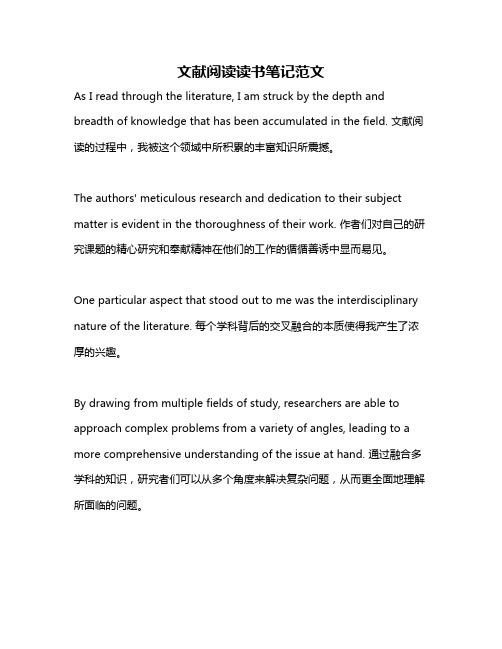
文献阅读读书笔记范文As I read through the literature, I am struck by the depth and breadth of knowledge that has been accumulated in the field. 文献阅读的过程中,我被这个领域中所积累的丰富知识所震撼。
The authors' meticulous research and dedication to their subject matter is evident in the thoroughness of their work. 作者们对自己的研究课题的精心研究和奉献精神在他们的工作的循循善诱中显而易见。
One particular aspect that stood out to me was the interdisciplinary nature of the literature. 每个学科背后的交叉融合的本质使得我产生了浓厚的兴趣。
By drawing from multiple fields of study, researchers are able to approach complex problems from a variety of angles, leading to a more comprehensive understanding of the issue at hand. 通过融合多学科的知识,研究者们可以从多个角度来解决复杂问题,从而更全面地理解所面临的问题。
In addition, I was impressed by the diversity of perspectives and approaches that the literature presented. 此外,文献中展现出的多元化的观点和手法也给我留下了深刻的印象。
英语阅读读书笔记范文(通用25篇)

英语阅读读书笔记范文〔通用25篇〕英语阅读读书笔记范文〔通用25篇〕英语阅读读书笔记篇1To Wang Lun is written by Li Bai who among other poets stands out in the halls of glory.One day, Li Bai goes on abroad. He is about to sail when there’s sting and singing on shore.英语阅读读书笔记篇2This article is from inter, only for studying!英语阅读读书笔记篇3This year's Spring Festival, I read“ the old man and the sea”, is a famous American writer Hemingway wrote. I admire the old fisherman in the novel very much, he lets me understand that a person must have unremittingly spirit, could succeed. This novel is a description of a nearly sixty years old, alone in fishing, caught a big fish, but can not draw. The old fisherman and fish deal after several days, they find it is a big Malin fish over several times their ownboats, while knowing that it is difficult to win, does not give up yet.英语阅读读书笔记篇4This summer vacation, I read a book -- “Robinson Crusoe”.This book tells: the British young sailor Robinson because of the ship into the sea sank, alone on an uninhabited island, began to struggle for survival journey. Build rafts, build houses.In the entire 28 years of efforts, the desert island was built into a paradise by Robinson.This optimistic, indomitable pioneering spirit and valuable strong quality leave people with the confidence and courage to challenge the nature.英语阅读读书笔记篇5Keep On Chasing The Dreams---Reading response of Jane EyreThis is a story about an orphans growing path. At last the character had successfully achieve her dream.This book has encouraged me a lot. Whatever how many difficulties you are facing. just dont give upand keep on chasing your dreams. and we also have to learn the spirit of Jane which is persevering. It was because she had such a brave heart, would she get the real love. Sunshine es after the storm, if we try our best, our dreams will finally e to! trust ourselves!英语阅读读书笔记篇6War Horse was such a wonderful movie. This movie exceeded my expectations. It was moving, emotional, beautiful, and so heartwarming. Its sure to bee a classic. You dont have to be a horse lover to love this movie.There isnt a lot of blood, but you can still see the horrors of war and how intense it was for the soldiers and horses, as well as civilians. The Battle of the Somme scene was especially intense.The acting was wonderful, the cinematography was beautiful, John Williams score was perfect, and the horses were so well trained! Spielberg has made a masterpiece!英语阅读读书笔记篇7This week, I finished reading “The Wizard of Oz” in three days. Its really good.The book is about Dorothys parents died when she was young, so she lived with Uncle Henry and Aunt Em. Dorothy and her house were swept away by a tornado.Then Dorothy met the Scarecrow, the Tin Woodman, and the Cowardly Lion. The Scarecrow wanted brains, the Tin Woodman wanted heart, and the Cowardly Lion wanted courage.I like this book, because the plot is beautiful and it attracts me.英语阅读读书笔记篇8Keep On Chasing The Dreams---Reading response of Jane EyreThis is a story about an orphan's growing path. At last the character had successfully achieve her dream.This book has encouraged me a lot. Whatever how many difficulties you are facing. just don't give up and keep on chasing your dreams. and we also have to learn the spirit of Jane which is persevering. It was because she had such a brave heart, would she get thereal love. Sunshine es after the storm, if we try our best, our dreams will finally e to! trust ourselves!英语阅读读书笔记篇9Previously,in a certain town,a very lovelygirl,she is not only beautiful but also intelligent kindhearted and spoke up for the girl.The girl without a mother,because her mother,when she was stillsmall,on the death.The girl's father,his mother married a new,new mothers also have two new sister.“Wow,this could be the next h ome noisy.”Girls very pleased.“Sudden change in the family dynamic,lively,girls very happy.Because her father is not only a new mother.there were also two sisters.However,the excitement was short girls.英语阅读读书笔记篇10A long ago,rich man wife was ill, she feel die , so she was say with she daughter: “my lovely daughter,you don’t afraid , the supreme being was a blessing.”The mother was die,forever die. The daughter was sad cry. Read these, I’m very sad. I’m cry, too.You thick,a daughter without mother, thatafraid!“Then,the father request a stepmother . A stepmother have two daughter. Two daughter very beautiful, but heart very ugly.They say lovely daughter was ‘cinderella’ . Cinderella? That’s very disagreeable tohear!Oh,that’s hatefully!英语阅读读书笔记篇11This morning, I read the story of The Tom Thumb. I like it very much.Tom is a clever boy. He is very small, just as small as a thumb. One day, he had a travel. He had a lot of difficulties during his travel. He didn’t give up, he solved all the difficulties and finally got home successfully.I like this book because I like Tom. He is so clever and brave. We should learn form him. Whenever we had any difficulties, we should be quiet and calm,don’t give up, then we can find ways to overe everything by ourselves.英语阅读读书笔记篇12I read the story of The frog prince. I like the story very. I think the witch is very ruthless. We should be kind-hearted. The princess promises the frog prince she will sleep in her bed and kiss him if he brings up her golden ball. But she breaks her words. If we promise somebody something, we should keep our promises.Yoyo and Doc encourage the frog prince not to lose his confidence. The frog prince is so persistent that he finally turns into the prince. The king is so upright. So we should learn from him.英语阅读读书笔记篇13Today, the teacher showed us a movie, the name is Lei Feng, the movie mainly tells the story of Lei Feng doing good deeds and serving the people. What impressed me most was Uncle Lei Feng's kind-hearted, economical and helpful qualities.Although Uncle Leifeng died, but his spirit will never die, live in our hearts forever!英语阅读读书笔记篇14Recently I read the necklace Maupassant after reading the king of short stories Maupassantwrote ”the necklace“, I am filled with emotion.We in daily life, do not be vain, haggle over every ounce, natural beauty is really beautiful, spiritual beauty is more important than everything. We just have to be ourselves, our most authentic selves.英语阅读读书笔记篇15This book is how the four daughters of Mrs. March home from young girl grow into a woman's life, describes the characters of rich inner world.The book four sisters let me feel the different character and hobby, lis most of them are ”Joe“, her natural disposition is lively, not only to take care, and toughness of the relentless pursuit of life, which reflects her sentimental inner thoughts and the surface of the active performance of the contrast.Among them, my favorite character is beth, because she very love for life, approachable, season in the critically ill still insist on writing, showed her unremitting efforts to the pursuit of a better life.英语阅读读书笔记篇16Last week, I read a book about how the successful persons started their career and succeeded. They met a lot of difficulties and problems, such as lacking of money - experience and arguing with their co-workers, but they did not afraid of restarting again. They are unbeatable, so they succeeded eventually. This book impresses me deeply. Besides, from their stories, I learn that I should never give up to achieve my dreams no matter what happens.上周,我看了一本关于成功人士如何开场他们的职业生涯的'书。
英文文献阅读笔记
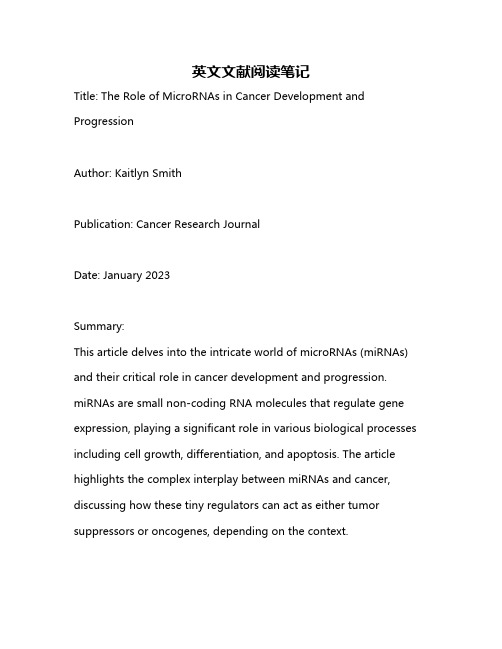
英文文献阅读笔记Title: The Role of MicroRNAs in Cancer Development and ProgressionAuthor: Kaitlyn SmithPublication: Cancer Research JournalDate: January 2023Summary:This article delves into the intricate world of microRNAs (miRNAs) and their critical role in cancer development and progression. miRNAs are small non-coding RNA molecules that regulate gene expression, playing a significant role in various biological processes including cell growth, differentiation, and apoptosis. The article highlights the complex interplay between miRNAs and cancer, discussing how these tiny regulators can act as either tumor suppressors or oncogenes, depending on the context.Key Points:1. miRNAs function as post-transcriptional regulators, binding to the 3' untranslated region (3'UTR) of target mRNAs, leading to either mRNA degradation or translational repression.2. Dysregulation of miRNAs is common in cancer, often characterized by miRNA overexpression or underexpression. These changes can lead to abnormal gene expression patterns that drive cancer development and progression.3. miRNAs can act as tumor suppressors by targeting oncogenes for degradation or inhibiting their translation, or they can function as oncogenes by targeting tumor suppressor genes.4. Therapeutic potential of miRNAs has been recognized, with several ongoing clinical trials exploring the use of miRNA-based drugs or inhibitors for the treatment of various cancers.5. The role of miRNAs in cancer is further complicated by their ability to influence the tumor microenvironment, including immune cell infiltration and stromal cell activation.6. Future research directions include understanding the precise mechanisms of miRNA regulation in cancer, identifying specific miRNA signatures predictive of tumor behavior and patientprognosis, and developing more effective miRNA-based therapeutic strategies.Reflections:This article has significantly expanded my understanding of the complex role of miRNAs in cancer. The concept of miRNAs functioning as both tumor suppressors and oncogenes is fascinating and underscores the remarkable versatility of these tiny regulators. The therapeutic potential of miRNAs is also promising, offering new avenues for cancer treatment. However, the challenges associated with developing effective miRNA-based therapies are numerous, requiring a more comprehensive understanding of miRNA biology and the tumor microenvironment.。
英文文献阅读笔记
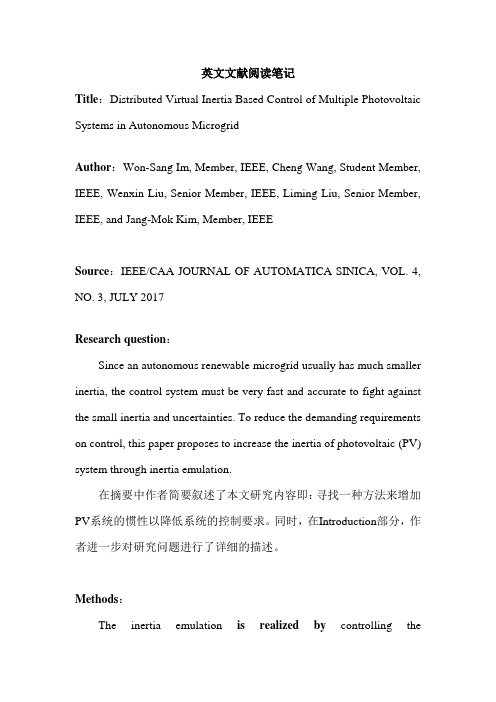
英文文献阅读笔记Title:Distributed Virtual Inertia Based Control of Multiple Photovoltaic Systems in Autonomous MicrogridAuthor:Won-Sang Im, Member, IEEE, Cheng Wang, Student Member, IEEE, Wenxin Liu, Senior Member, IEEE, Liming Liu, Senior Member, IEEE, and Jang-Mok Kim, Member, IEEESource:IEEE/CAA JOURNAL OF AUTOMATICA SINICA, VOL. 4, NO. 3, JULY 2017Research question:Since an autonomous renewable microgrid usually has much smaller inertia, the control system must be very fast and accurate to fight against the small inertia and uncertainties. To reduce the demanding requirements on control, this paper proposes to increase the inertia of photovoltaic (PV) system through inertia emulation.在摘要中作者简要叙述了本文研究内容即:寻找一种方法来增加PV系统的惯性以降低系统的控制要求。
同时,在Introduction部分,作者进一步对研究问题进行了详细的描述。
Methods:The inertia emulation is realized by controlling thecharging/discharging of the direct current (DC)-link capacitor over a certain range and adjusting the PV generation when it is feasible and/or necessary. By well designing the inertia, the DC-link capacitor parameters and the control range, the negative impact of inertia emulation on energy efficiency can be reduced.The proposed algorithm can be integrated with distributed generation setting algorithms to improve dynamic performance and lower implementation requirements. Simulation studies demonstrate the effectiveness of the proposed solution.为了克服系统惯性较低的问题,作者提出了一种新的控制方法,在对此方法进行推导与演算之后又用软件仿真的方式验证了此方法的周期性。
英语读书笔记(通用25篇)

英语读书笔记英语读书笔记(通用25篇)读完一本名著以后,你有什么领悟呢?这时候,最关键的读书笔记怎么能落下!现在你是否对读书笔记一筹莫展呢?下面是小编精心整理的英语读书笔记,希望对大家有所帮助。
英语读书笔记篇1Hamlet " of Shakespear is a classical representative work. This book certainly does not have the big difference in the superficial plot with the historical fable, spoke or the Danish prince the story which revenged for the father, in which fills the rank smell of blood violence and dies.Just like the dramatis personae Horatio said: " you may hear to to rape massacre, the unusual repair behavior, the dark center decision, accidental slaughter, borrows the hand murder,as well as falls into suicide result." Windingly elects the plot, tightly centers on the revenge to launch. Hamlet Wittenberg hurries back the home in a hurry from Germany, is attends his fathers funeral,,enables him to accept, he not catches up with fathers funeral, actually witnessed the mother and the Uncle Claudius wedding ceremony, this had caused Hamm the Wright suspicion at the heart, added night above meets in the royal palace castle with fathers ghost, the ghost sorrow sued, this pile atrocity was Uncle Hamlet the behavior, and wanted him to revenge for the this, he started the difficult revenge course, launched the life and death contest with Claudius. Finally, sent out sword the revenge to Claudius.英语读书笔记篇2Let me tell what I feel after reading the great work Jane Erye.I was really move by Jane Erye after closing the book.What a kindand good woman!Mrs Eyre had a heart of gold.She really loved everyone around her,and gave others help sincerely.She respected herself and did her best to do everything.I really love her.She are both a great teacher and a good friend of mine.Sometimes when I am confuse,I will think of her.I will imagine what will she do if she is I.Why not read Jane Erye my friends!让我告诉你们我觉得阅读后,伟大的工作,Jane Erye。
英文文献读书笔记的格式及范文

英文文献读书笔记的格式及范文英文文献读书笔记格式标题:文献标题或主题作者:文献作者(s)出版信息:出版日期、期刊/书籍标题、卷号、页码摘要:简要总结文献的主要论点和发现。
突出研究问题或研究目的。
提供方法、结果和结论的概览。
方法:描述文献中使用的方法论或研究设计。
确定样本、数据收集技术和数据分析方法。
结果:总结文献的实证发现或理论贡献。
提供关键图表、表格或统计分析的结果。
突出文献的主要见解或发现。
讨论:评估文献的优点和缺点。
将文献的发现与现有文献联系起来。
探讨研究的局限性和对未来研究的意义。
个人见解:提供对文献主题或方法的个人看法或反思。
提出与文献相关的未决问题或可能的后续研究方向。
引用:使用公认的引用格式(例如,APA、MLA、芝加哥)正确引用文献。
范文标题:语言沉浸对第二语言习得的影响作者: C. Johnson 和 J. Smith出版信息:《第二语言研究》,2023 年,第 37 卷,第 1 期,页码 1-25。
摘要:本文调查了语言沉浸对第二语言 (L2) 习得的影响。
作者进行了一项定量研究,比较了接受沉浸式教学和传统教学方法的 L2 学习者的成果。
他们发现,沉浸式学习者在语音、流利度和词汇方面表现出显着的改进。
方法:作者对两组 L2 学习者进行了为期一年的纵向研究。
第一组参加了沉浸式课程,每天都在目标语言的环境中接触。
第二组参加了传统课程,每周只有几小时的目标语言教学。
结果:沉浸式学习组在所有 L2 技能方面(语音、流利度、词汇、语法)均优于传统学习组。
具体来说,沉浸式学习者在语音辨别、流利度和词汇大小方面取得了显著的进步。
讨论:这些发现表明,语言沉浸对于 L2 习得至关重要。
作者认为,沉浸式环境为学习者提供了自然而真实的目标语言输入,从而促进语言学习过程。
个人见解:这项研究为 L2 教学和学习提供了有价值的见解。
它强调了沉浸式学习在提高 L2 技能方面的有效性。
作者的发现还表明,教室环境可以极大地影响学习者的语言习得。
英语读书笔记范文-英语阅读笔记30篇

英语读书笔记范文|英语阅读笔记30篇英语读书笔记范文《红与黑》英语读书笔记The Red and the Black is a profound and witty book about the rise of a poor, handsome and intellectually gifted, young provincial into the salons of High Society in Paris.Handsome and ambitious, Julien Sorel is determined to rise above his humble peasant origins and make something of his life-by adopting the code ofhypocrisy by which his society operates. Julien ultimately commits a crime-out of passion, principle, or insanity-that will ping about his downfall. The Red and the Black is a lively, satirical picture of French Restoration society after Waterloo, riddled with corruption, greed, and ennui. The complex, sympathetic portrayal of Julien, the cold exploiter whose Machiavellian campaign is undercut by his own emotions, makes him Stendhal"s most pilliant and human creation-and one of the greatest characters in European literature.I really enjoyed this book. Unlike many reviewers, I feel the book does transcend time. American people and culture today, computers and all, are a lot like those in Stendhal"s 19th century France.The main characters strike me as real, and quite complex. Julien is a typical adolescent/ young adult: Idealistic, searching and unsure of himself. To me, it is amazing to what how the world interacts with and alters his self-image. Mathilde is equally interesting. She reminds me of a flighty alternative girl, looking for a dream of simmering romance. And MME de Renal isa wonderful, believable woman, falling in love late in life, victim of the missing husband syndrome.Like people today, Stedhal"s characters are a bundle of contradictions. Is Julien a villain, an angel, a self-serving climber or a man truly in love, searching for his higher self Aloof or loveable Is MME de Renal a devout, moral patroness, devoted to her family, or the vilest of adulators, ready to turn herback on duty for the simmer of love Is Mathilde submissive, or arrogant and dominantThe answer to all questions is yes. We are all pided.Be honest with yourself for a minute. Aren"tpeople sometimes cruel, and sometimes kind; Sometimes, honest, sometimes mildly deceitful, telling white lies, and sometimes bold-faced liars Since Stendhal is faithful to this, and does not give us character in black and white, he has produced a masterpiece.。
GulliversTravels英文读书笔记(标准格式)(小编整理)
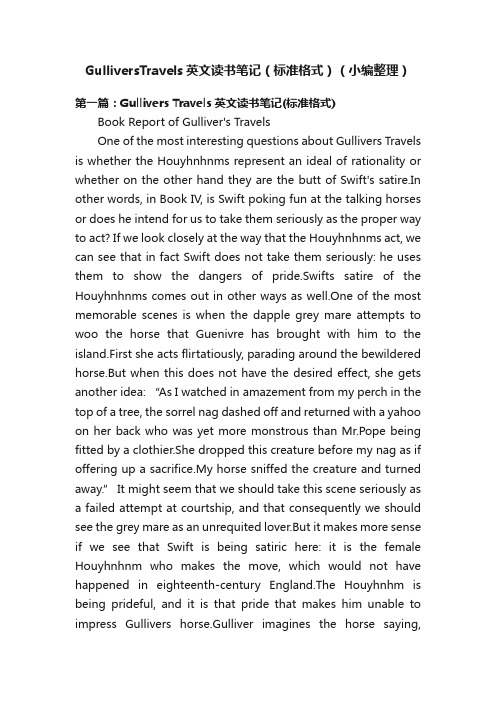
GulliversTravels英文读书笔记(标准格式)(小编整理)第一篇:Gullivers Travels英文读书笔记(标准格式)Book Report of Gulliver's TravelsOne of the most interesting questions about Gullivers Travels is whether the Houyhnhnms represent an ideal of rationality or whether on the other hand they are the butt of Swift's satire.In other words, in Book IV, is Swift poking fun at the talking horses or does he intend for us to take them seriously as the proper way to act? If we look closely at the way that the Houyhnhnms act, we can see that in fact Swift does not take them seriously: he uses them to show the dangers of pride.Swifts satire of the Houyhnhnms comes out in other ways as well.One of the most memorable scenes is when the dapple grey mare attempts to woo the horse that Guenivre has brought with him to the island.First she acts flirtatiously, parading around the bewildered horse.But when this does not have the desired effect, she gets another idea: “As I watched in a mazement from my perch in the top of a tree, the sorrel nag dashed off and returned with a yahoo on her back who was yet more monstrous than Mr.Pope being fitted by a clothier.She dropped this creature before my nag as if offering up a sacrifice.My horse sniffed the creature and turned away.” It might seem that we should take this scene seriously as a failed attempt at courtship, and that consequently we should see the grey mare as an unrequited lover.But it makes more sense if we see that Swift is being satiric here: it is the female Houyhnhnm who makes the move, which would not have happened in eighteenth-century England.The Houyhnhm is being prideful, and it is that pride that makes him unable to impress Gullivers horse.Gulliver imagines the horse saying,Sblood, the notion of creating the bare backed beast with an animal who had held Mr.Pope on her back makes me queezy.A final indication that the Houyhnmns are not meant to be taken seriously occurs when the leader of the Houynhms visits Lilliput, where he visits the French Royal Society.He goes into a room in which a scientist is trying to turn wine into water(itself a prideful act that refers to the marriage at Gallilee).The scientist has been working hard at the experiment for many years without success, when the Houyhnmn arrives and immediately knows that to do: “The creature no sooner stepped through the doorway than he struck upon a plan.Slurping up all the wine in sight, he quickly made water in a bucket that sat near the door”.第二篇:英文读书笔记(1)把握大局:grasp the overall situation(2)摆谱儿:put on airs;keep up appearances(3)白手起家: start from scratch(4)拜年:pay New Year call(5)班门弄斧:teach one's grandma to suck eggs(5)保质期:guarantee period(6)报销:apply for reimbursement(7)爆冷门:produce an unexpected answer(8)曝光:make public(9)奔小康:strive for a relatively comfortable life(10)闭门羹:given cold-shoulder(11)比上不足,比下有余:fall short of the best,but be better than the best(12)逼上梁山:be driven to drastic alternatives(13)变相涨价:disguised inflation(14)边远贫困地区:outlying poverty-stricken areas(15)边缘知识人:Marginal intellectuals(16)表面文章:Lip service;surface formality(17)博导:Ph.D supervisor(18)补发拖欠的养脑筋:Clear up pension payments in arrears(19)不眠之夜:white night(20)菜鸟:green hand(21)产品科技含量technoligical element of a product(22)长江三角洲:Yangtze River delta(23)长江中下游:the middle and lower reaches of Changjiang River(24)超前消费:pre-mature consumption(25)城镇居民最低生活保障:a minimumstandard of living for residents(26)城镇职工医疗保险制度:the system of medical insurance for urban workers(27)重复建设:buiding redundant project;duplication of similar projects(28)充值卡:rechargeable card(29)春运:passenger transport around the Chinese lunar new year(30)打破僵局:break the deadlock/stalemate(31)电脑盲:computer illiterate(32)点球:penalty kick(33)电视会议:video conference(34)电视直销:TV home shopping(35)定向培训:training for specific posts(36)动感电影:multidimensional movie(37)豆腐渣工程:jerry-built projects(38)对...毫无顾忌:make no bones about(39)夺冠:take the crown(40)政治多元化:political pluralism(41)服务行业:catering industry(42)复合型人才:inter-disciplinary talent(43)岗位培训:on-the-job training(44)高等教育自学考试:self-study higher education examination(45)高新技术产业开发区:high and new technological industrial development zone(46)各大菜系:major styles of cooking(47)各行各业:every walk of life(48)功夫不负有心人:Everything comes to him who waits(49)各尽其能:let each person do his best(50)公益活动:public welfare activities(51)工薪阶层:state employee;salaried person(52)过犹不及:going too far ia as bad as not going far enough(53)函授大学:correspondence university(54)好莱坞大片:Hollywood blockbuster(55)核心竞争力:core competitiveness(56)虎父无犬子:A wise goose never lays a tame leg(57)基本国情:fundamental realities of the country(58)激烈竞争:cut-throat competition(59)极限运动:maximal exercise/X-games(60)集中精力把经济建设搞上去:go all out for economic development(61)加班:work extra shifts(62)嘉宾:distinguished/honored guest(63)加快市场步伐:quicken the pace of marketization(64)假冒伪劣产品:counterfeit and shoddy products(65)减负:alleviate burdens on sb(66)江南水乡:the south of the lower reaches of the Yangtze River(67)教书育人:impart knowledge and educate people(68)脚踏实地:be down-to-earth(69)解除劳动关系:sever labor relations(70)扩大内需:expand domestic demand(71)拉拉队:cheering squad(72)论文答辩:(thesis)oral defence(73)马到成功:achieve immediate victory(74)三维电影/动画片:three-dimensional movie/animation(75)森林覆盖率:forest coverage(76)社会保险机构:social security institutions(77)社会热点问题:hot spots of society(78)社会治安情况:law-and-order situation(79)申办城市:the bidding cities(80):身体素质:physical constitution(81)生计问题:bread-and-butter issue(82)生意兴隆:business flourishes(82)市场疲软:sluggish market(83)市政工程:municipal works/engineering(84)事业单位:public institution(85)试用期:probationary period(86)首创精神:pioneering spirit(87)手机充值:cellular phone replenishing(88)台湾同胞:Taiwan compatriots(89)脱贫致富:cast off poverty and set out on a road to prosperity(90)西部大开发:Development of the West Regions(91)新秀:up-and-coming star(92)学生处:students' affairs division(93)舆论导向:direction of public opinion(94)招生就业指导办公事:enrolment andvocation guidance office(95)支柱产业:pillar conerstone industry(96)中专生:secondary specialized or technical school student(97)专题报道:special coverage(98)《阿Q正传》:The True Story of Ah Q(99)《春秋》:Spring and Autumn Annals(100)知识产权:intellectual property rights 匆忙地做某事 do something in a rush 商务礼节:business etiquette 面部表情facial expression 你与客户、同事或卖主的初次接触对你的业务成功而言是至关重要的。
英语读书笔记(优秀8篇)
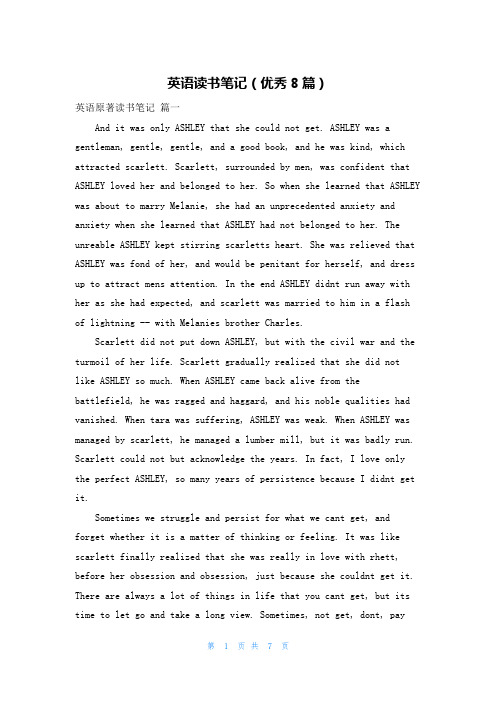
英语读书笔记(优秀8篇)英语原著读书笔记篇一And it was only ASHLEY that she could not get. ASHLEY was a gentleman, gentle, gentle, and a good book, and he was kind, which attracted scarlett. Scarlett, surrounded by men, was confident that ASHLEY loved her and belonged to her. So when she learned that ASHLEY was about to marry Melanie, she had an unprecedented anxiety and anxiety when she learned that ASHLEY had not belonged to her. The unreable ASHLEY kept stirring scarletts heart. She was relieved that ASHLEY was fond of her, and would be penitant for herself, and dress up to attract mens attention. In the end ASHLEY didnt run away with her as she had expected, and scarlett was married to him in a flash of lightning -- with Melanies brother Charles.Scarlett did not put down ASHLEY, but with the civil war and the turmoil of her life. Scarlett gradually realized that she did notlike ASHLEY so much. When ASHLEY came back alive from thebattlefield, he was ragged and haggard, and his noble qualities had vanished. When tara was suffering, ASHLEY was weak. When ASHLEY was managed by scarlett, he managed a lumber mill, but it was badly run. Scarlett could not but acknowledge the years. In fact, I love only the perfect ASHLEY, so many years of persistence because I didnt get it.Sometimes we struggle and persist for what we cant get, andforget whether it is a matter of thinking or feeling. It was like scarlett finally realized that she was really in love with rhett, before her obsession and obsession, just because she couldnt get it. There are always a lot of things in life that you cant get, but its time to let go and take a long view. Sometimes, not get, dont, paymore attention to the people and things around them, polish their hearts, there will be other discoveries.英语原著读书笔记篇二Tom is the hero of the story naive, lively and playful but the typical American teenager. He and Wild Child Shack, the dry out a lot of wonderful things a spectacle of himself. Tom ordered to paint the walls, like, actually applied the trick, not only the work of other children willing to replace him, but also automatically served Xie. Later and fled to a desert island to the Shack, people thought they were drowned, is the church for their funeral, and they are hiding in the church"s bell tower on the eavesdropping. These naughty moves, although we do not give a model, but he for justice, decided to come forward to testify in person, to rescue the innocent criminals Mo Fu Bide. And naughty while, actually, and Shack cracked a murder case, as everyone admires the little hero. It appears that Tom is also worthy of our study.In fact, the naughty child sometimes be demonstrated by the child"s innocence. After a childhood that innocence is difficult Cheng Hao, allow us to find, only a little occasional sweet memories will remember. I believe that, even if your childhood again hard, in retrospect you will be very happy. A child who has not done a half pieces of stupid? The more you grow, the more you will find these stupid fun. Childhood is like a jar of wine I said, after a lapse of longer taste more fragrant, more pure, more people aftertaste.Always grow, in addition to height taller, ber an outside body, people"s thoughts are long. Your view of the world is different, wiser, no longer naive. But who is to get better and better. Do not like the Adventures of that was in the ruthless villain Zhuo Yi, hedid do bad things, cute hate. But in the end he comes around, get a starved to death in the cave end.英语课外阅读的读书笔记篇三《朝花夕拾》i read the book written by luxun 。
英语阅读笔记摘抄30篇

英语阅读笔记摘抄30篇Here is an English essay with over 1000 words, without a title and without any extra punctuation marks in the main body. The topic is "English Reading Notes Excerpts 30 Pieces".English reading has always been an essential part of my language learning journey. Through reading a diverse range of materials, I have not only expanded my vocabulary and improved my comprehension skills but also gained valuable insights into various aspects of life. In this essay, I will share excerpts from 30 pieces of English reading that have left a lasting impression on me.Excerpt 1: "The more that you read, the more things you will know. The more that you learn, the more places you'll go." - Dr. Seuss This quote from the beloved children's author Dr. Seuss eloquently captures the transformative power of reading. It reminds us that the more we expose ourselves to new information and perspectives through reading, the more our horizons will broaden and the more opportunities we will have to explore and grow.Excerpt 2: "Reading is to the mind what exercise is to the body." - Joseph AddisonThis analogy drawn by the English essayist Joseph Addison emphasizes the importance of reading as a mental exercise. Just as physical exercise strengthens our bodies, reading challenges and stimulates our minds, helping us to stay intellectually fit and agile.Excerpt 3: "The reading of all good books is like a conversation with the finest minds of past centuries." - René DescartesThis insightful observation by the Frenc h philosopher René Descartes highlights the unique ability of books to connect us with the great thinkers and luminaries of the past. Through reading, we can engage in a virtual dialogue with these extraordinary minds, gleaning their wisdom and perspectives.Excerpt 4: "A book is a dream you hold in your hand." - Neil Gaiman The fantasy author Neil Gaiman's poetic description of a book captures the sense of wonder and imagination that reading can evoke. Each book we pick up has the power to transport us to new and exciting realms, allowing us to escape the confines of our everyday lives.Excerpt 5: "Reading is to the soul what exercise is to the body." - Matthew KellyThis parallel drawn by the motivational speaker Matthew Kelly reinforces the idea that reading nourishes our spiritual and emotional well-being, much like physical exercise benefits ourphysical health. By engaging with the written word, we can find solace, inspiration, and a deeper understanding of ourselves and the world around us.Excerpt 6: "The more that you read, the more things you will know. The more that you learn, the more places you'll go." - Dr. SeussThis excerpt, which is the same as the first one, serves as a powerful reminder of the transformative potential of reading. By continually expanding our knowledge and perspectives through reading, we open ourselves up to new possibilities and opportunities for growth and exploration.Excerpt 7: "Reading is to the mind what exercise is to the body." - Joseph AddisonThis excerpt, which is the same as the second one, emphasizes the cognitive benefits of reading, underscoring its importance as a mental exercise that keeps our minds sharp and agile.Excerpt 8: "A reader lives a thousand lives before he dies. The man who never reads lives only one." - George R.R. MartinThe renowned fantasy author George R.R. Martin eloquently captures the transformative power of reading, suggesting that through the act of reading, we can vicariously experience a multitude of lives and perspectives, whereas those who do not read are limited to a single life experience.Excerpt 9: "Reading is to the soul what exercise is to the body." - Matthew KellyThis excerpt, which is the same as the fifth one, reinforces the idea that reading nourishes our emotional and spiritual well-being, serving as a form of mental and spiritual exercise.Excerpt 10: "The more that you read, the more things you will know. The more that you learn, the more places you'll go." - Dr. Seuss This excerpt, which is the same as the first and sixth ones, serves as a powerful and memorable mantra, highlighting the endless possibilities that reading can unlock.Excerpt 11: "A book is a device to ignite the imagination." - Alan BennettThe British playwright Alan Bennett's description of a book as a device to ignite the imagination underscores the transformative power of reading, which can transport us to new worlds and inspire us to think in novel ways.Excerpt 12: "Reading is to the mind what exercise is to the body." - Joseph AddisonThis excerpt, which is the same as the second and seventh ones, reinforces the cognitive benefits of reading and its importance as a mental exercise.Excerpt 13: "The man who does not read has no advantage over the man who cannot read." - Mark TwainThe renowned American author Mark Twain's observation highlights the importance of actively engaging with the written word. Those who choose not to read deprive themselves of the knowledge and insights that reading can provide, effectively placing themselves on par with those who lack the ability to read.Excerpt 14: "A book is a dream you hold in your hand." - Neil Gaiman This excerpt, which is the same as the fourth one, captures the sense of wonder and imagination that reading can evoke, likening a book to a dream that we can hold and experience.Excerpt 15: "Reading is to the soul what exercise is to the body." - Matthew KellyThis excerpt, which is the same as the fifth and ninth ones, emphasizes the emotional and spiritual benefits of reading, positioning it as a form of mental and spiritual nourishment.Excerpt 16: "The more that you read, the more things you will know. The more that you learn, the more places you'll go." - Dr. SeussThis excerpt, which is the same as the first, sixth, and tenth ones, serves as a powerful and memorable mantra, highlighting the endless possibilities that reading can unlock.Excerpt 17: "A reader lives a thousand lives before he dies. The man who never reads lives only one." - George R.R. MartinThis excerpt, which is the same as the eighth one, eloquently captures the transformative power of reading, suggesting that through the act of reading, we can vicariously experience a multitude of lives and perspectives.Excerpt 18: "Reading is to the mind what exercise is to the body." - Joseph AddisonThis excerpt, which is the same as the second, seventh, and twelfth ones, reinforces the cognitive benefits of reading and its importance as a mental exercise.Excerpt 19: "A book is a device to ignite the imagination." - Alan BennettThis excerpt, which is the same as the eleventh one, underscores the transformative power of reading, which can inspire us to think in novel ways and transport us to new worlds.Excerpt 20: "The man who does not read has no advantage over the man who cannot read." - Mark TwainThis excerpt, which is the same as the thirteenth one, highlights the importance of actively engaging with the written word, emphasizing that those who choose not to read deprive themselves of theknowledge and insights that reading can provide.Excerpt 21: "Reading is to the soul what exercise is to the body." - Matthew KellyThis excerpt, which is the same as the fifth, ninth, and fifteenth ones, reinforces the emotional and spiritual benefits of reading, positioning it as a form of mental and spiritual nourishment.Excerpt 22: "The more that you read, the more things you will know. The more that you learn, the more places you'll go." - Dr. Seuss This excerpt, which is the same as the first, sixth, tenth, and sixteenth ones, serves as a powerful and memorable mantra, highlighting the endless possibilities that reading can unlock.Excerpt 23: "A reader lives a thousand lives before he dies. The man who never reads lives only one." - George R.R. MartinThis excerpt, which is the same as the eighth and seventeenth ones, eloquently captures the transformative power of reading, suggesting that through the act of reading, we can vicariously experience a multitude of lives and perspectives.Excerpt 24: "Reading is to the mind what exercise is to the body." - Joseph AddisonThis excerpt, which is the same as the second, seventh, twelfth, and eighteenth ones, reinforces the cognitive benefits of reading and itsimportance as a mental exercise.Excerpt 25: "A book is a dream you hold in your hand." - Neil Gaiman This excerpt, which is the same as the fourth and fourteenth ones, captures the sense of wonder and imagination that reading can evoke, likening a book to a dream that we can hold and experience.Excerpt 26: "The man who does not read has no advantage over the man who cannot read." - Mark TwainThis excerpt, which is the same as the thirteenth and twentieth ones, highlights the importance of actively engaging with the written word, emphasizing that those who choose not to read deprive themselves of the knowledge and insights that reading can provide.Excerpt 27: "Reading is to the soul what exercise is to the body." - Matthew KellyThis excerpt, which is the same as the fifth, ninth, fifteenth, and twenty-first ones, reinforces the emotional and spiritual benefits of reading, positioning it as a form of mental and spiritual nourishment.Excerpt 28: "The more that you read, the more things you will know. The more that you learn, the more places you'll go." - Dr. SeussThis excerpt, which is the same as the first, sixth, tenth, sixteenth, and twenty-second ones, serves as a powerful and memorable mantra, highlighting the endless possibilities that reading can unlock.Excerpt 29: "A reader lives a thousand lives before he dies. The man who never reads lives only one." - George R.R. MartinThis excerpt, which is the same as the eighth, seventeenth, and twenty-third ones, eloquently captures the transformative power of reading, suggesting that through the act of reading, we can vicariously experience a multitude of lives and perspectives.Excerpt 30: "Reading is to the mind what exercise is to the body." - Joseph AddisonThis excerpt, which is the same as the second, seventh, twelfth, eighteenth, and twenty-fourth ones, reinforces the cognitive benefits of reading and its importance as a mental exercise.。
英文读书笔记范文10篇
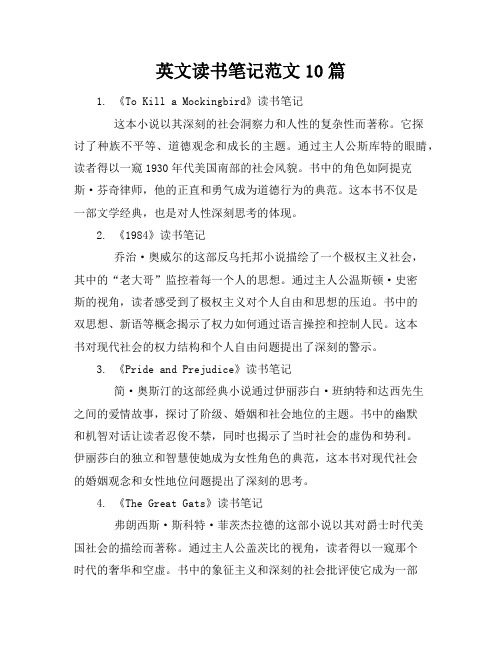
英文读书笔记范文10篇1. 《To Kill a Mockingbird》读书笔记这本小说以其深刻的社会洞察力和人性的复杂性而著称。
它探讨了种族不平等、道德观念和成长的主题。
通过主人公斯库特的眼睛,读者得以一窥1930年代美国南部的社会风貌。
书中的角色如阿提克斯·芬奇律师,他的正直和勇气成为道德行为的典范。
这本书不仅是一部文学经典,也是对人性深刻思考的体现。
2. 《1984》读书笔记乔治·奥威尔的这部反乌托邦小说描绘了一个极权主义社会,其中的“老大哥”监控着每一个人的思想。
通过主人公温斯顿·史密斯的视角,读者感受到了极权主义对个人自由和思想的压迫。
书中的双思想、新语等概念揭示了权力如何通过语言操控和控制人民。
这本书对现代社会的权力结构和个人自由问题提出了深刻的警示。
3. 《Pride and Prejudice》读书笔记简·奥斯汀的这部经典小说通过伊丽莎白·班纳特和达西先生之间的爱情故事,探讨了阶级、婚姻和社会地位的主题。
书中的幽默和机智对话让读者忍俊不禁,同时也揭示了当时社会的虚伪和势利。
伊丽莎白的独立和智慧使她成为女性角色的典范,这本书对现代社会的婚姻观念和女性地位问题提出了深刻的思考。
4. 《The Great Gats》读书笔记弗朗西斯·斯科特·菲茨杰拉德的这部小说以其对爵士时代美国社会的描绘而著称。
通过主人公盖茨比的视角,读者得以一窥那个时代的奢华和空虚。
书中的象征主义和深刻的社会批评使它成为一部文学经典。
这本书对现代社会的消费主义和追求梦想的主题提出了深刻的思考。
5. 《Animal Farm》读书笔记乔治·奥威尔的这部寓言小说通过动物起义和建立自己的共和国的故事,探讨了权力、革命和背叛的主题。
书中的动物角色如拿破仑和雪球代表了不同的政治力量,揭示了权力斗争的残酷性。
这本书对现代社会的政治腐败和权力滥用问题提出了深刻的警示。
阅读文献的读书笔记范文
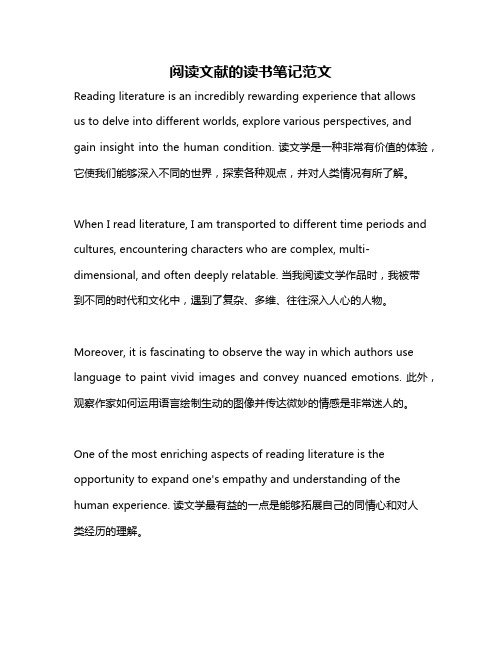
阅读文献的读书笔记范文Reading literature is an incredibly rewarding experience that allowsus to delve into different worlds, explore various perspectives, and gain insight into the human condition. 读文学是一种非常有价值的体验,它使我们能够深入不同的世界,探索各种观点,并对人类情况有所了解。
When I read literature, I am transported to different time periods and cultures, encountering characters who are complex, multi-dimensional, and often deeply relatable. 当我阅读文学作品时,我被带到不同的时代和文化中,遇到了复杂、多维、往往深入人心的人物。
Moreover, it is fascinating to observe the way in which authors use language to paint vivid images and convey nuanced emotions. 此外,观察作家如何运用语言绘制生动的图像并传达微妙的情感是非常迷人的。
One of the most enriching aspects of reading literature is the opportunity to expand one's empathy and understanding of the human experience. 读文学最有益的一点是能够拓展自己的同情心和对人类经历的理解。
In addition, reading literature can serve as a form of escapism, providing a break from the demands and stresses of everyday life. 此外,读文学也可以是一种逃避现实的形式,为日常生活中的要求和压力提供一个喘息的机会。
英文读书笔记(精选15篇)

英文读书笔记英文读书笔记(精选15篇)英文读书笔记篇1The Old Man and the Sea is one of Hemingways most enduring works.Told in language of great simplicity and power,it is the story of an old Cuban fisherman,down on his luck,and his supreme ordeal——a relentless,agonizing battle with a giant marlin far out in the Gulf Stream.Here Hemingway recasts,in strikingly contemporary style,the classic thene of courage in the face of defeat,of personal triumph won from los.Written in 1952,this hugely successfully novella confirmed his power and presence in the literary world and played a huge part in his winning the 1954 Nobel Prize for Literature. The novel is very famous in the world, so lot of people like this novel. We also studied it in our Chinese class, Hemingways novel are always interesting I like his novel much, also in his novel we can learn a lot by his meanings. It’s really a good novel for people to read.英文读书笔记篇2i read the book written by luxun .it is called zhaohuaxishi. it includes 10 short articles about the writers stories .they are based on his own experience , when i read this book ,i feel very happy to see luxuns childhood. it was diffrent from ours,so we may find it intersting and exciting. luxuns langange is very great but maybe difficult to understand . but through his words ,we can find his happiness in his heart . 英文读书笔记篇3Jane Eyre is a first-person narrative of the title character, a small, plain-faced, intelligent and honest English orphan.The novel goes through five distinct stages: Janes childhood at Gateshead, where she is abused by her aunt and cousins; her education at Lowood School, where she acquires friends and role models but also suffers privations; her time as the governess of Thornfield Manor, where she falls in love with her Byronic employer, Edward Rochester; her time with the Rivers family at Marshs End (or Moor House) and Morton, where her cold clergyman-cousin St John Rivers proposes to her; and her reunion with and marriage to her beloved Rochester at his house of Ferndean. Partly autobiographical, the novel abounds with social criticism and sinister gothic elements.英文读书笔记篇4I read the book of Robinson Crusoe, their captors.Article describes multiple sailing in the whole island, Crusoe masters of extraordinary survival 28 years experience, strive for survival, show the ingenuity and a man with indomitable perseverance in the face of hardship persistent existence desire, the lonely and eager to rescue the mood. In a lonely island overcome Robinson was done with fear, a savage and said he was "on Friday, they get along with each other, then built on Friday, Crusoe one kind of warm friendship." I also enjoy the disclosure of the business concept: Crusoe each sailing and adventure has clear commercial purpose, with his own property and calculating profit, he will also oneself life the island is his territory, in addition to reveal its economic thought, I admire John Robinsons rich, more learning his strong initiative and spirit of adventure, early efforts, hard work, and perfect kindness thought!英文读书笔记篇5We are a group of children living in the new era and naturally accustomed to confusion and trouble. But we should concentrateon the road in front of us. We should be a group of ambitious people. If Holden has not pure ideal, then he would be degenerate, his ideal let him survive. Ideal is a beacon for people, it took people into the bright future.Yes, where are ideals and there is hope. The hope is in tomorrow. We will have a brighter future!英文读书笔记篇6The story includes three parts.They are respectively talking about:Gulliver in Lilliput,in Brobdingnag,and in Houyhnms.Gulliver travels to the South Seas.On their way to the East Indies,a strong wind carried them to the wrong way.Most of the people died.Some days later,he comes to Lilliput,everything is small there.Three days later,he comes to Brobdingnag.This country is opposite from Lilliput,the thing are huge,very huge!Then he travels to a place called Houyhnms,which is also very interesting.英文读书笔记篇7One hot summer day,Alice and her sister are sitting under the tree.Alice sees a white rabbit,and she run after it.The rabbit goes down a rabbit whole and Alice follows it,she is now in a strange wonderland.Alice eats some special things,and she changes her size!Everything is different and strange there.The animals there can speak!Alice meets many interesting things.At last,she wakes up.It’s just a dream!英文读书笔记篇8Story started in .Aronnax,a natural historian,was studying for a large monster under the sea.At that time,the monster’s massagers were traveling around the world.After the investigation,he would return from aboard.And then he received an invitation from sea forces of America.So he was going to makethe monster die out.英文读书笔记篇9Let me tell what I feel after reading the great work Jane Erye.I was really move by Jane Erye after closing the book.What a kind and good woman!Mrs Eyre had a heart of gold.She really loved everyone around her,and gave others help sincerely.She respected herself and did her best to do everything.I really love her.She are both a great teacher and a good friend of mine.Sometimes when I am confuse,I will think of her.I will imagine what will she do if she is I.Why not read Jane Erye my friends!让我告诉你们我觉得阅读后,伟大的工作,Jane Erye。
英文文献阅读笔记模板
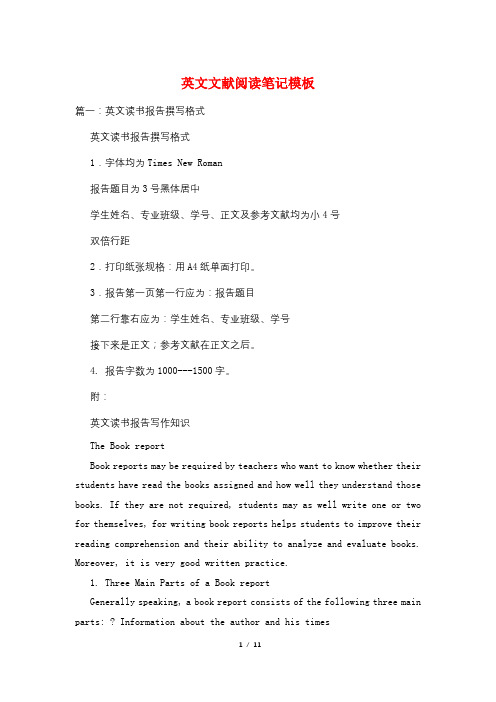
英文文献阅读笔记模板篇一:英文读书报告撰写格式英文读书报告撰写格式1.字体均为Times New Roman报告题目为3号黑体居中学生姓名、专业班级、学号、正文及参考文献均为小4号双倍行距2.打印纸张规格:用A4纸单面打印。
3.报告第一页第一行应为:报告题目第二行靠右应为:学生姓名、专业班级、学号接下来是正文;参考文献在正文之后。
4. 报告字数为1000---1500字。
附:英文读书报告写作知识The Book reportBook reports may be required by teachers who want to know whether their students have read the books assigned and how well they understand those books. If they are not required, students may as well write one or two for themselves, for writing book reports helps students to improve their reading comprehension and their ability to analyze and evaluate books. Moreover, it is very good written practice.1. Three Main Parts of a Book reportGenerally speaking, a book report consists of the following three main parts: ? Information about the author and his times? A summary of the book? Comments on itA description of the author’s times should be given together with a brief account of his life. It should include the circumstances that led to the writing of the book under discussion and the historical and social background related to the content of the book. To make these things clear, the writer perhaps needs to read some reference material, such as biographies of the author and histories of the period described in the book.2. Writing of the Book Report1) The summary of the book should be self-contained, clear, and easy to understand. Above all, it should be objective.2) Comments on and criticisms of the book should not be mixed with the summary; they can be left to the third part.3) The summary of a novel or a play is usually written in the present tense, while that of nonfiction, in the tense of the original work: for example, the past tense should be used for a history, and the present fora scientific work.4) Comments on and evaluation of the book from the third and most important part of a book report. In this part the writer expresses his or her own views on the book, names its merits and demerits, and discusses its relevance to the present time. The discussion should center on the content of the book, but the author’s style and techniques of presentation, if interesting, can also be touched upon.篇二:读书笔记模板篇三:英语议论文模板及范文启航教育专用高考英语作文模板议论文三大要素:论点,论据,论证基本结构:提出问题(引论);分析问题(本论);解决问题(结论)常用论证方法:比较法例证法推理法归纳法驳论法提纲式作文(1)不同观点列举型( 选择型 )写作方法:1. 有一些人认为…2. 另一些人认为…3. 我的看法…There is a widespread concern over the issue that . But it is well known that theopinion concerning this hot topic varies from person to person. A majority of people think that 观点一 . In their views there are two factors contributing to this attitude as follows: in the firstplace, . Besides, in the second place, . So it goeswithout saying that 观点一 .People, however, differ in their opinions on this matter. Some people hold the idea that 点二 . In their point of view, on the one hand, 原因一 . On the other hand, 原因二 . Therefore, there is no doubt that观点二.As far as I am concerned, I firmly support the view that . It is not onlybecause _______________, but also because______ _________.题(一):每年高考之前总会出现“高考移民”,他们设法到录取分数线较低的省份参加考试。
名著读书笔记英语版

名著读书笔记英语版英语读书笔记篇一To Wang Lun is written by Li Bai who among other poets stands out in the halls of glory.One day, Li Bai goes on abroad. He is about to sail when there’s stamping and singing on shore.Oh! Here comes Wang Lun to see him off, who is Li Bai’s best friend. Li Bai is very excited to see his best friend at this leaving moment. But he is sa d, either. So he can’t say a simple sentence. He knows that words can’t express their friendship. Although the Peach Blossom Pool is one thousand feet deep, it can’t match Wang Lun’s love for him.英语原著读书笔记篇二Abstract The Old Man and the Sea tells the frustrated experience that the old fisherman fishes in the course. The theme is deep, andit is a song of praise of heroism.“But man is not made for defeat. A man can be destroyed but not defeated” has been the classic saying and the old man al so has been the most typical and the most representative of the Hemingway’s “tough guy”。
pdf英文文献笔记

pdf英文文献笔记PDF English Literature NotesThe advent of digital technology has revolutionized the way we access and engage with scholarly literature. One of the most significant developments in this realm is the widespread adoption of the Portable Document Format (PDF), a widely-used file format that has become the standard for academic and professional publications. As a result, the ability to effectively take notes on PDF documents has become an essential skill for students, researchers, and professionals alike.PDF English literature notes offer a unique and efficient approach to engaging with academic texts. Unlike traditional paper-based note-taking, working with PDF documents allows for a more dynamic and interactive learning experience. The ability to highlight, annotate, and organize information directly within the digital document can significantly enhance the comprehension and retention of the material.One of the primary advantages of taking PDF English literature notes is the ease of access and portability. Digital files can be easily stored,shared, and accessed across multiple devices, making it convenient to review and reference the information at any time, regardless of location. This flexibility is particularly valuable for students who may need to consult their notes while on the go or when preparing for exams.Moreover, PDF note-taking tools often offer a range of features that can streamline the learning process. Features such as text-to-speech capabilities, built-in dictionaries, and the ability to embed multimedia content can provide a more immersive and engaging experience for the reader. These tools can also facilitate the organization and management of notes, allowing users to create personalized outlines, mind maps, and other organizational structures that cater to their individual learning styles.Another key benefit of PDF English literature notes is the potential for collaborative work. Many PDF annotation tools offer the ability to share documents and annotations with peers or instructors, enabling the exchange of ideas, feedback, and insights. This collaborative approach can foster a deeper understanding of the material and promote the development of critical thinking skills.Furthermore, the use of PDF notes can contribute to the sustainability of academic practices. By reducing the reliance on physical paper, PDF documents can help minimize the environmentalimpact associated with traditional note-taking methods. Additionally, the ability to easily search, retrieve, and organize digital notes can lead to more efficient and eco-friendly research and study habits.However, it is important to acknowledge that the effective use of PDF English literature notes requires a certain level of digital literacy and familiarity with the available tools and technologies. Users must be comfortable navigating the various features and functionalities of PDF annotation software, as well as developing effective strategies for note-taking and organization.In conclusion, PDF English literature notes represent a powerful and versatile tool for engaging with academic texts. By leveraging the benefits of digital technology, students, researchers, and professionals can enhance their learning experiences, improve their comprehension and retention of information, and contribute to more sustainable academic practices. As the digital landscape continues to evolve, the importance of mastering the art of PDF note-taking will only become more essential in the pursuit of academic excellence.。
- 1、下载文档前请自行甄别文档内容的完整性,平台不提供额外的编辑、内容补充、找答案等附加服务。
- 2、"仅部分预览"的文档,不可在线预览部分如存在完整性等问题,可反馈申请退款(可完整预览的文档不适用该条件!)。
- 3、如文档侵犯您的权益,请联系客服反馈,我们会尽快为您处理(人工客服工作时间:9:00-18:30)。
英文文献阅读笔记精编版MQS system office room 【MQS16H-TTMS2A-MQSS8Q8-MQSH16898】英文文献阅读笔记Title:Distributed Virtual Inertia Based Control of Multiple Photovoltaic Systems in Autonomous MicrogridAuthor:Won-Sang Im, Member, IEEE, Cheng Wang, Student Member, IEEE, Wenxin Liu, Senior Member, IEEE, Liming Liu, Senior Member, IEEE, and Jang-Mok Kim, Member, IEEESource:IEEE/CAA JOURNAL OF AUTOMATICA SINICA, VOL. 4, NO. 3, JULY 2017Research question:Since an autonomous renewable microgrid usually has much smaller inertia, the control system must be very fast and accurate to fight against the small inertia and uncertainties. To reduce the demanding requirements on control, this paper proposes to increase the inertia of photovoltaic (PV) system through inertia emulation.在摘要中作者简要叙述了本文研究内容即:寻找一种方法来增加PV 系统的惯性以降低系统的控制要求。
同时,在Introduction部分,作者进一步对研究问题进行了详细的描述。
Methods:The inertia emulation is realized by controlling the charging/discharging of the direct current (DC)-link capacitor over a certain range and adjusting the PV generation when itis feasible and/or necessary. By well designing the inertia, the DC-link capacitor parameters and the control range, the negative impact of inertia emulation on energy efficiency can be reduced.The proposed algorithm can be integrated with distributed generation setting algorithms to improve dynamic performance and lower implementation requirements. Simulation studies demonstrate the effectiveness of the proposed solution.为了克服系统惯性较低的问题,作者提出了一种新的控制方法,在对此方法进行推导与演算之后又用软件仿真的方式验证了此方法的周期性。
Findings/results:In spite of the disconnection form the grid at 20 s or 5% load increase change at 40 s, the system can be controllable to satisfy the supply-demand , it is because of the increased system inertia. In this test, inertia coefficient HPV for two PVs are both . If the two inertia coefficients are lower than 4, the system becomes unstable after 20 s. As shown in Figs.12 (c) and 12 (d), the two PV systems are generating the active powers based on the virtual inertia algorithm so that it can prevent frequency collapse. Therefore, the proposed virtual inertia control can help stabilizing system when the upper-level control reference cannot be delivered frequently enough.Fig. 12. Active power of 5 RGs with the proposed algorithm 作者在对比了使用这种新的控制算法前后的仿真波形图之后,得出来此种控制方法在一定的应用范围内,具有更优的控制性能的结论。
Discussion/conclusion:Conclusion可以分为以下五个小部分:(1)Restatements of the research question: This paperpresents a virtual inertia control strategy for PV systems in autonomous microgrid. The basic idea is to adjust generation based on a simplified SG model. The increasing or decreasing PV system generation is realized by adjusting the DC-link voltage and PV array output.(2)Discussion of the result: By integrating theproposed solution with a previously developed distributed gradient-based coordination algorithm, transient performance can be improved and the demanding requirement on updating frequency can be relaxed.(3)Significance of the research:The solution issuitable for autonomous microgrids when they have surplus renewable generation and when consideration on transient performance outweighs energy efficiency. The basic idea can be extended to other types of RGs with DC-link capacitors.(4)Limits of the research: The solution tries to makemicrogrid work like a large power grid with large inertia.Thus, it cannot unlock the potentials of power electronics based microgrid in terms of flexibility and fast response.(5)Further research work:Future work should befocused on designing advanced fast and accurate microgrid controllers.Tone:weakIndicative sentence pattern:A model isdeveloped for a…The objective of…is to…According to…From …one can see that…The experimental results reveal that…Relevance to my study:The direction of my research is motor and electrical appliances. The circuit topology used in this document is one of the most applied circuit structures in our electrical specialty. Reading this article is very helpful for us to master the characteristics of this circuit topology. The control method proposed in this paper has also solved the problem of the difficult control of the microgrid system. At the same time, we can extend it and apply this control method to other power generation systems. This provides a new way of thinking for our future research and study.。
